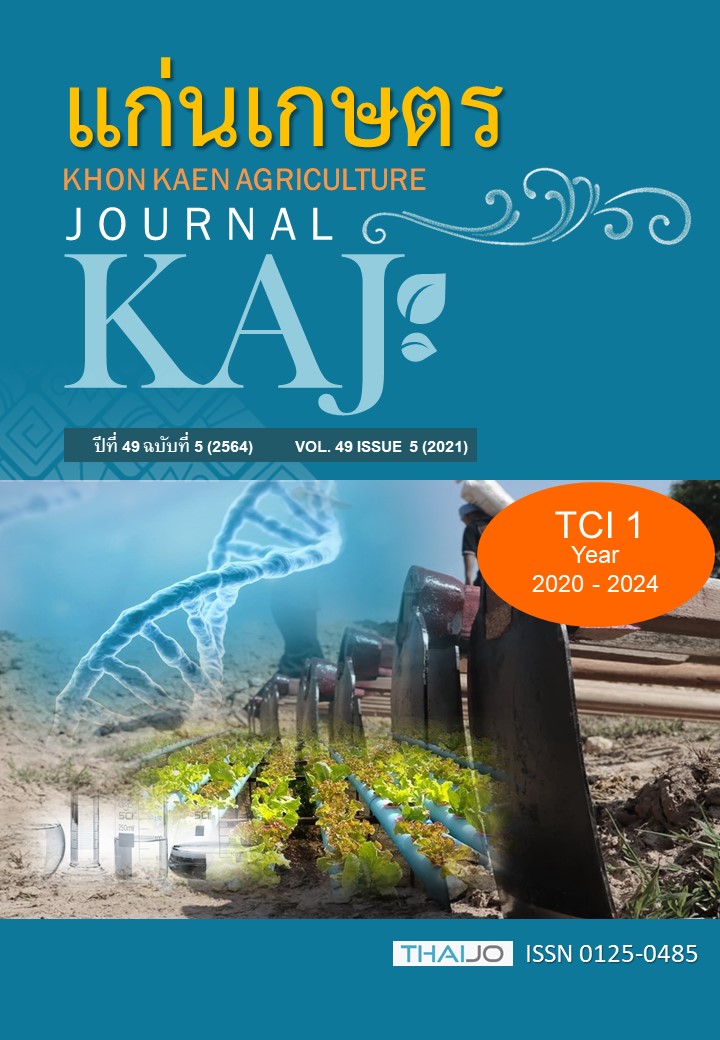อิทธิพลของพ่อแม่ต่อลักษณะใบและความสัมพันธ์กับผลผลิตในลูกผสมกลับข้ามชนิดของสบู่ดำ
Main Article Content
บทคัดย่อ
การคัดเลือกสายพันธุ์พ่อแม่มีความสำคัญต่อการปรับปรุงพันธุ์สบู่ดำลูกผสม และลักษณะใบอาจใช้ประโยชน์ในการคัดเลือกสายพันธุ์สบู่ดำที่มีผลผลิตสูง การศึกษานี้จึงมีวัตถุประสงค์เพื่อ 1) ศึกษาอิทธิพลของสายพันธุ์พ่อแม่ต่อลักษณะใบและผลผลิตของสบู่ดำลูกผสมกลับข้ามชนิด และ 2) หาความสัมพันธ์ระหว่างลักษณะใบและผลผลิตของสบู่ดำลูกผสม โดยปลูกทดสอบลูกผสมกลับข้ามชนิดระหว่างสบู่ดำกับเข็มปัตตาเวีย 45 คู่ผสม ซึ่งได้จากสายพันธุ์แม่ 5 สายพันธุ์ กับพันธุ์พ่อ 9 สายพันธุ์ บันทึกผล SPAD chlorophyll meter reading (SCMR), พื้นที่ใบจำเพาะ (specific leaf area; SLA), พื้นที่ใบเฉลี่ย, น้ำหนักใบเฉลี่ย และผลผลิตรวมในรอบ 1 ปี พบว่า สบู่ดำสายพันธุ์แม่มีอิทธิพลต่อลักษณะใบและผลผลิตของลูกผสม แต่ไม่พบอิทธิพลของสายพันธุ์พ่อในทุกลักษณะ และยังพบอิทธิพลของปฏิสัมพันธ์ระหว่างสายพันธุ์พ่อแม่ต่อลักษณะใบและผลผลิตของลูกผสม พบความสัมพันธ์ระดับสูงระหว่าง SCMR กับ SLA (r = -0.73** และ -0.75**) จึงสามารถใช้ SCMR ในการประเมิน SLA ของสบู่ดำลูกผสม และยังพบความสัมพันธ์ ระหว่างลักษณะผลผลิตกับ SCMR (r = -0.36* ถึง -0.72**), SLA (r = 0.33* ถึง 0.66**), พื้นที่ใบเฉลี่ย (r = 0.37* ถึง 0.69**) และน้ำหนักใบเฉลี่ย (r = 0.33* ถึง 0.38**) ดังนั้น จึงสามารถใช้ลักษณะใบเหล่านี้เป็นสิ่งประเมินทางอ้อมในการคัดเลือกสบู่ดำลูกผสมที่มีศักยภาพสูงด้านผลผลิต
Article Details

อนุญาตภายใต้เงื่อนไข Creative Commons Attribution-NonCommercial-NoDerivatives 4.0 International License.
เอกสารอ้างอิง
สินีนาฎ เกิดทรัพย์, พัชรินทร์ ตัญญะ, พรศิริ เลี้ยงสกุล และ อนุรักษ์ อรัญญนาค. 2559. ศักยภาพผลผลิตเนื้อไม้ของลูกผสมข้ามชนิดในพืชสกุล Jatropha. วารสารวิทยาศาสตร์เกษตร. 47: 361-364.
อนุรักษ์ อรัญญนาค, พัชรินทร์ ตัญญะ, พรศิริ เลี้ยงสกลุ และ พีระศักดิ์ ศรีนิเวศน์. 2561. การประเมินผลผลิตและชีวมวลในสบู่ดำลูกผสมภายในชนิดและลูกผสมข้ามชนิด. แก่นเกษตร. 46: 1191-1202.
อนุรักษ์ อรัญญนาค, สินีนาฎ เกิดทรัพย์, พัชรินทร์ ตัญญะ, พรศิริ เลี้ยงสกุล และ พีระศักดิ์ ศรีนิเวศน์. 2562. การเปรียบเทียบศักยภาพทางชีวมวลในลูกผสมข้ามชนิดของพืชสกุล Jatropha. แก่นเกษตร. 47: 917-928.
อนุรักษ์ อรัญญนาค, วิไลรัตน์ ฤกษ์วิรี , พัชรินทร์ ตัญญะ, พรศิริ เลี้ยงสกุล และ พีระศักดิ์ ศรีนิเวศน์. 2563a. อิทธิพลของสายพันธุ์พ่อแม่และการตัดฟันต่อการเจริญเติบโตและผลผลิตชีวมวลของลูกผสมข้ามชนิดระหว่างสบู่ดำกับเข็มปัตตาเวีย. แก่นเกษตร. 48: 249-260.
อนุรักษ์ อรัญญนาค, วิไลรัตน์ ฤกษ์วิรี , พัชรินทร์ ตัญญะ, พรศิริ เลี้ยงสกุล และ พีระศักดิ์ ศรีนิเวศน์. 2563b. สหสัมพันธ์ของลักษณะการเจริญเติบโตและผลผลิตชีวมวลในลูกผสมข้ามชนิดระหว่างสบู่ดำกับเข็มปัตตาเวีย. แก่นเกษตร. 48: 823-834.
Amanullah. 2015. Specific leaf area and specific leaf weight in small grain crops wheat, rye, barley, and oats differ at various growth stages and NPK source. Journal of Plant Nutrition. 38: 1694-1708.
Azevedo Peixoto, L.d., P.E. Teodoro, L.A. Silva, E.V. Rodrigues, B.G. Laviola, and L.L. Bhering. 2018. Jatropha half-sib family selection with high adaptability and genotypic stability. PLOS ONE. 13(7): e0199880.
Laosatit, K., P. Tanya, N. Muakrong, and P. Srinives. 2014. Development of interspecific and intergeneric hybrids among jatropha-related species and verification of the hybrids using EST–SSR markers. Plant Genetic Resources. 12: 58-61.
Marenco, R.A., S.A. Antezana-Vera, and H.C.S. Nascimento. 2009. Relationship between specific leaf area, leaf thickness, leaf water content and SPAD-502 readings in six Amazonian tree species. Photosynthetica. 47: 184-190.
Montes, J.M., and A.E. Melchinger. 2016. Domestication and breeding of Jatropha curcas L. Trends in Plant Science. 21: 1045-1057.
Muakrong, N., K.T. One, P. Tanya, and P. Srinives. 2014. Interspecific jatropha hybrid as a new promising source of woody biomass. Plant Genetic Resources. 12: 17-20.
Muakrong, N., C. Phetcharat, P. Tanya, and P. Srinives. 2020. Breeding field crops for ornamental purpose: A case in Jatropha spp. Agrivita. 36: 229-234.
Nyi, N., W. Sridokchan, W. Chai-arree, and P. Srinives. 2012. Nondestructive measurement of photosynthetic pigments and nitrogen status in Jatropha (Jatropha curcas L.) by chlorophyll meter. Philippine Agricultural Scientist. 95: 83–89.
Senger, E., A. Peyrat, M. Martin, and J.M. Montes. 2014. Genetic variation in leaf chlorophyll content of Jatropha curcas L. Industrial Crops and Products. 58: 204–211.
Senger, E., M. Martin, E. Dongmeza, and J.M Montes. 2016. Genetic variation and genotype by environment interaction in Jatropha curcas L. germplasm evaluated in different environments of Cameroon. Biomass and Bioenergy. 91: 10-16.
Tar, M.M., N. Nyi, P. Tanya, and P. Srinives. 2011. Genotype by environment interaction of Jatropha (Jatropha curcas L.) grown from seedlings vs cuttings. Thai Journal of Agricultural Science. 44(2): 71-79.
One, K.T., N. Muakrong, P. Tanya, J. Velette, P. Girard, and P. Srinives. 2014. Physicochemical properties of seeds and oil from an F2 population of Jatropha curcas × Jatropha integerrima. Science Asia. 40: 428–435.
Tjeuw, J., M. Slingerland, and K. Giller. 2015. Relationships among Jatropha curcas seed yield and vegetative plant components under different management and cropping systems in Indonesia. Biomass and Bioenergy. 80: 128-139.
Wani, S.P., G. Chander, K.L. Sahrawat, C.S. Rao, G. Raghvendra, P. Susanna, and M. Pavani. 2012. Carbon sequestration and land rehabilitation through Jatropha curcas (L.) plantation in degraded lands. Agriculture, Ecosystems & Environment. 161: 112-120.


